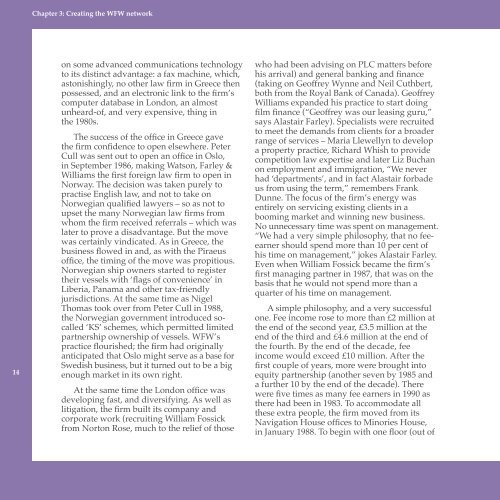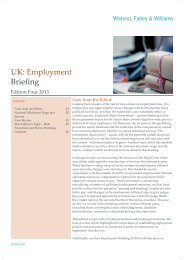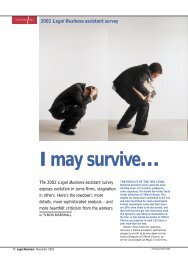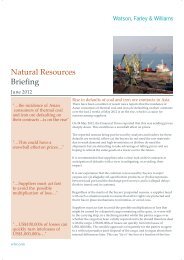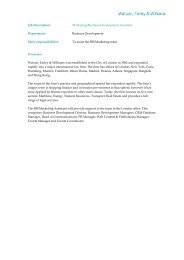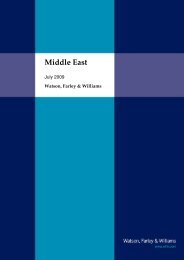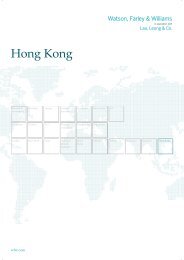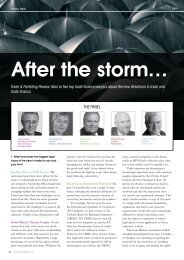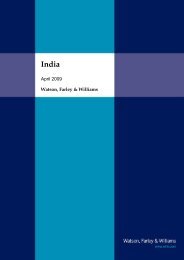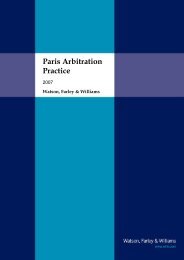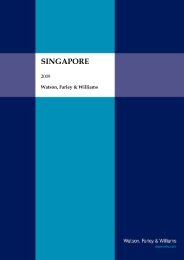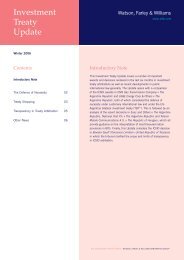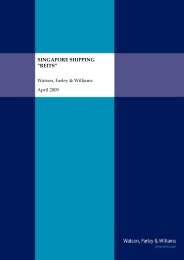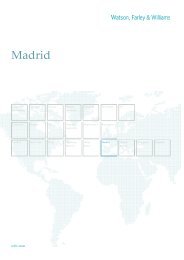The Spirit of Enterprise 25 years of Watson, Farley & Williams
The Spirit of Enterprise 25 years of Watson, Farley & Williams
The Spirit of Enterprise 25 years of Watson, Farley & Williams
Create successful ePaper yourself
Turn your PDF publications into a flip-book with our unique Google optimized e-Paper software.
14<br />
Chapter 3: Creating the WFW network<br />
on some advanced communications technology<br />
to its distinct advantage: a fax machine, which,<br />
astonishingly, no other law firm in Greece then<br />
possessed, and an electronic link to the firm’s<br />
computer database in London, an almost<br />
unheard-<strong>of</strong>, and very expensive, thing in<br />
the 1980s.<br />
<strong>The</strong> success <strong>of</strong> the <strong>of</strong>fice in Greece gave<br />
the firm confidence to open elsewhere. Peter<br />
Cull was sent out to open an <strong>of</strong>fice in Oslo,<br />
in September 1986, making <strong>Watson</strong>, <strong>Farley</strong> &<br />
<strong>Williams</strong> the first foreign law firm to open in<br />
Norway. <strong>The</strong> decision was taken purely to<br />
practise English law, and not to take on<br />
Norwegian qualified lawyers – so as not to<br />
upset the many Norwegian law firms from<br />
whom the firm received referrals – which was<br />
later to prove a disadvantage. But the move<br />
was certainly vindicated. As in Greece, the<br />
business flowed in and, as with the Piraeus<br />
<strong>of</strong>fice, the timing <strong>of</strong> the move was propitious.<br />
Norwegian ship owners started to register<br />
their vessels with ‘flags <strong>of</strong> convenience’ in<br />
Liberia, Panama and other tax-friendly<br />
jurisdictions. At the same time as Nigel<br />
Thomas took over from Peter Cull in 1988,<br />
the Norwegian government introduced socalled<br />
‘KS’ schemes, which permitted limited<br />
partnership ownership <strong>of</strong> vessels. WFW’s<br />
practice flourished; the firm had originally<br />
anticipated that Oslo might serve as a base for<br />
Swedish business, but it turned out to be a big<br />
enough market in its own right.<br />
At the same time the London <strong>of</strong>fice was<br />
developing fast, and diversifying. As well as<br />
litigation, the firm built its company and<br />
corporate work (recruiting William Fossick<br />
from Norton Rose, much to the relief <strong>of</strong> those<br />
who had been advising on PLC matters before<br />
his arrival) and general banking and finance<br />
(taking on Ge<strong>of</strong>frey Wynne and Neil Cuthbert,<br />
both from the Royal Bank <strong>of</strong> Canada). Ge<strong>of</strong>frey<br />
<strong>Williams</strong> expanded his practice to start doing<br />
film finance (“Ge<strong>of</strong>frey was our leasing guru,”<br />
says Alastair <strong>Farley</strong>). Specialists were recruited<br />
to meet the demands from clients for a broader<br />
range <strong>of</strong> services – Maria Llewellyn to develop<br />
a property practice, Richard Whish to provide<br />
competition law expertise and later Liz Buchan<br />
on employment and immigration, “We never<br />
had ‘departments’, and in fact Alastair forbade<br />
us from using the term,” remembers Frank<br />
Dunne. <strong>The</strong> focus <strong>of</strong> the firm’s energy was<br />
entirely on servicing existing clients in a<br />
booming market and winning new business.<br />
No unnecessary time was spent on management.<br />
“We had a very simple philosophy, that no feeearner<br />
should spend more than 10 per cent <strong>of</strong><br />
his time on management,” jokes Alastair <strong>Farley</strong>.<br />
Even when William Fossick became the firm’s<br />
first managing partner in 1987, that was on the<br />
basis that he would not spend more than a<br />
quarter <strong>of</strong> his time on management.<br />
A simple philosophy, and a very successful<br />
one. Fee income rose to more than £2 million at<br />
the end <strong>of</strong> the second year, £3.5 million at the<br />
end <strong>of</strong> the third and £4.6 million at the end <strong>of</strong><br />
the fourth. By the end <strong>of</strong> the decade, fee<br />
income would exceed £10 million. After the<br />
first couple <strong>of</strong> <strong>years</strong>, more were brought into<br />
equity partnership (another seven by 1985 and<br />
a further 10 by the end <strong>of</strong> the decade). <strong>The</strong>re<br />
were five times as many fee earners in 1990 as<br />
there had been in 1983. To accommodate all<br />
these extra people, the firm moved from its<br />
Navigation House <strong>of</strong>fices to Minories House,<br />
in January 1988. To begin with one floor (out <strong>of</strong>


